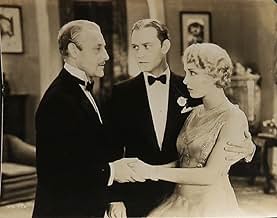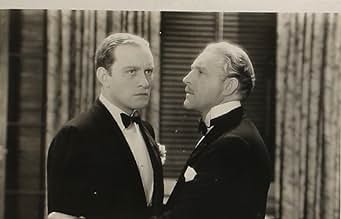Füge eine Handlung in deiner Sprache hinzuEdward Wales stages a seance to catch his friend's murderer. With 13 suspects, one kills again during the seance. The medium investigates when someone close is accused, aiming to expose the ... Alles lesenEdward Wales stages a seance to catch his friend's murderer. With 13 suspects, one kills again during the seance. The medium investigates when someone close is accused, aiming to expose the real culprit.Edward Wales stages a seance to catch his friend's murderer. With 13 suspects, one kills again during the seance. The medium investigates when someone close is accused, aiming to expose the real culprit.
- Regie
- Drehbuch
- Hauptbesetzung
- Auszeichnungen
- 1 wins total
- Dr. Philip Mason
- (as Charles Quartermaine)
Empfohlene Bewertungen
Lugosi's character is investigating a murder - two actually. At the beginning of the film, Spencer Lee, described by his own best friend as a rotter, has already been murdered by person unknown. Apparently Lee was quite a lady's man and generally just a bad guy all around, so any number of people could have killed him. The best friend, Edward Wales, suggests a séance conducted by the previously named mystic. Meanwhile, the son of an aristocratic family (Conrad Nagel as Richard Crosby) is having trouble with his fiancée (Leila Hyams as Helen O'Neil) who says she has no right to marry him. Richard thinks it is because she is a secretary and he comes from a rich family, but there is obviously something else troubling Helen a great deal.
The séance is held in the Crosby home, and the participants see this mainly as an interesting diversion, but when the time comes for Wales to ask the spirit of his dead friend, Spencer Lee, who murdered him, there is a scream, and when the lights come on, Wales is dead with a knife in his back. Supposedly this was done by someone in the séance circle to prevent the spirit of Spencer Lee from answering his friend.
Several other reviewers note Bela Lugosi as the reason to watch this one, but I pick Margaret Wycherly as the psychic. She plays one of the oddest and most intriguing characters of any era of film. She acts more like a tour guide in her friendliness than a mystic, and then proceeds to show everybody all of her tricks when she is faking as a means of proving that this time she is not faking. She actually solves the crime with the help of Lugosi's character, who, upon hearing her idea to expose the murderer says "What you propose is too horrible to contemplate – but we will do it!" She gives such an odd but likable performance it is a wonder she wasn't nominated for best actress.
This early talkie is not too talkie - in that there may be quite a bit of conversation, but it is all for a purpose. It really is quite creative throughout and the plot twists will keep you guessing. I recommend it, just remember you are dealing with the limitations of very early sound film, which primarily was movement.
Being a filmed stage play in the very early talky era, The Thirteenth Chair doesn't have much action. What it does have is Bela Lugosi who becomes the focus of the film as Inspector Delzante as soon as he makes an appearance. There are few surprises to anyone who has seen very many mysteries, but a few genuinely spooky scenes occur in the darkened room as the sound takes over and your imagination is allowed to supply the imagery. On the prints that I have seen the sound is of a poor quality with a high level of hiss as in so many older films. It takes some dedication to sit through, and listening carefully to understand all the dialogue. It is fascinating to see Lugosi as a key supporting character before he was typecast.
It also feels like it has a few minutes missing from the start - or I'm a bit dense!! Everyone seems to know what's going on already - renowned womaniser Spencer Lee has been killed by a woman - but which woman??? Ned Wales (John Davidson) is the only person in the house who liked Lee (Spencer had saved him from drowning when they were children) and who is determined to find his killer. Even he acts suspiciously, trying to bribe the servants (again, the action obviously takes place in India but the audience is never told). There is an establishing shot of the two leads, Richard Crosby (Conrad Nagel) is trying to convince Helen O'Neill (Leila Hyams) to marry him. It's the old "you may be only my mother's secretary but you're good enough for me" routine. Nagel and Hyams may have been the leads but they are only required to stand around looking worried, fearful, determined etc.
The stage is set for the show down between the real stars - wonderful Margaret Wycherley as the medium Madame La Grange, an unassuming "nanny" type, who nevertheless, has a few secrets and menacing Bela Lugosi as Inspector Delzante and he still manages to act like Dracula. Even though that film role was 2 years in the future he had played it on Broadway on and off during the 20s. Just to hear him say "What you propose is too horrible to contemplate - but we will do it!!!
Margaret Wycherley was a character actress supreme. She really hit her stride in the 40s and even though you struggle to remember some of the movies, you definitely remember her ("Johnny Angel" - she played a domineering nanny). Of course she was Ma Jarrett in "White Heat" and Ma Forrester in "The Yearling" - "my boy, my poor crookedy boy". In "The Thirteenth Chair" she was a breath of fresh air and proved stage actors weren't always stiff. Her husband, Bayard Veiller wrote the original play "The Thirteenth Chair" that had a healthy run of 328 performances, back in 1916 and in which Margaret Wycherley played the same role of Rosalie La Grange.
Recommended.
Wusstest du schon
- WissenswertesCompleted July 16 1929, the first sound feature in which Bela Lugosi's famous Hungarian tones were heard. This was Bela Lugosi's first venture with Browning. Two years later, the director cast him in the film version of the Bram Stoker vampire tale after Chaney, Browning's first choice for the role, died. Lugosi and Browning made one other film together, Mark of the Vampire (1935), in which he played Count Mora, a knock-off of his more famous blood-sucking cousin.
- PatzerThere are several scenes where it appears the actors are waiting for their cues before they start talking, most notably when the Inspector calls them all into the room to re-create the séance.
It isn't a "goof" that the actors seem to be waiting for their cues before they start acting. Many of the earliest MGM talkies employed a technique of long, lingering inactive moments at the beginning and ending of reels, which apparently were supposed to take the place of a leader when they changed over, perhaps accommodating the Vitaphone print versions. Years ago, when these titles appeared on TV, they didn't do that, so maybe Movietone versions were more succinctly edited.
- Zitate
Inspector Delzante: [Interrogating Madame La Grange, consulting his notes] Perhaps this will refresh your memory.
- Alternative VersionenMGM also released this movie in a silent version at 1628.55 m in length. The silent version of the film is considered lost as of February 2021.
- VerbindungenReferenced in You Must Remember This: Bela and the Vampires (Bela & Boris Part 2) (2017)
Top-Auswahl
Details
- Erscheinungsdatum
- Herkunftsland
- Sprache
- Auch bekannt als
- The 13th Chair
- Drehorte
- Produktionsfirma
- Weitere beteiligte Unternehmen bei IMDbPro anzeigen
- Laufzeit1 Stunde 12 Minuten
- Farbe
- Seitenverhältnis
- 1.20 : 1
Zu dieser Seite beitragen































